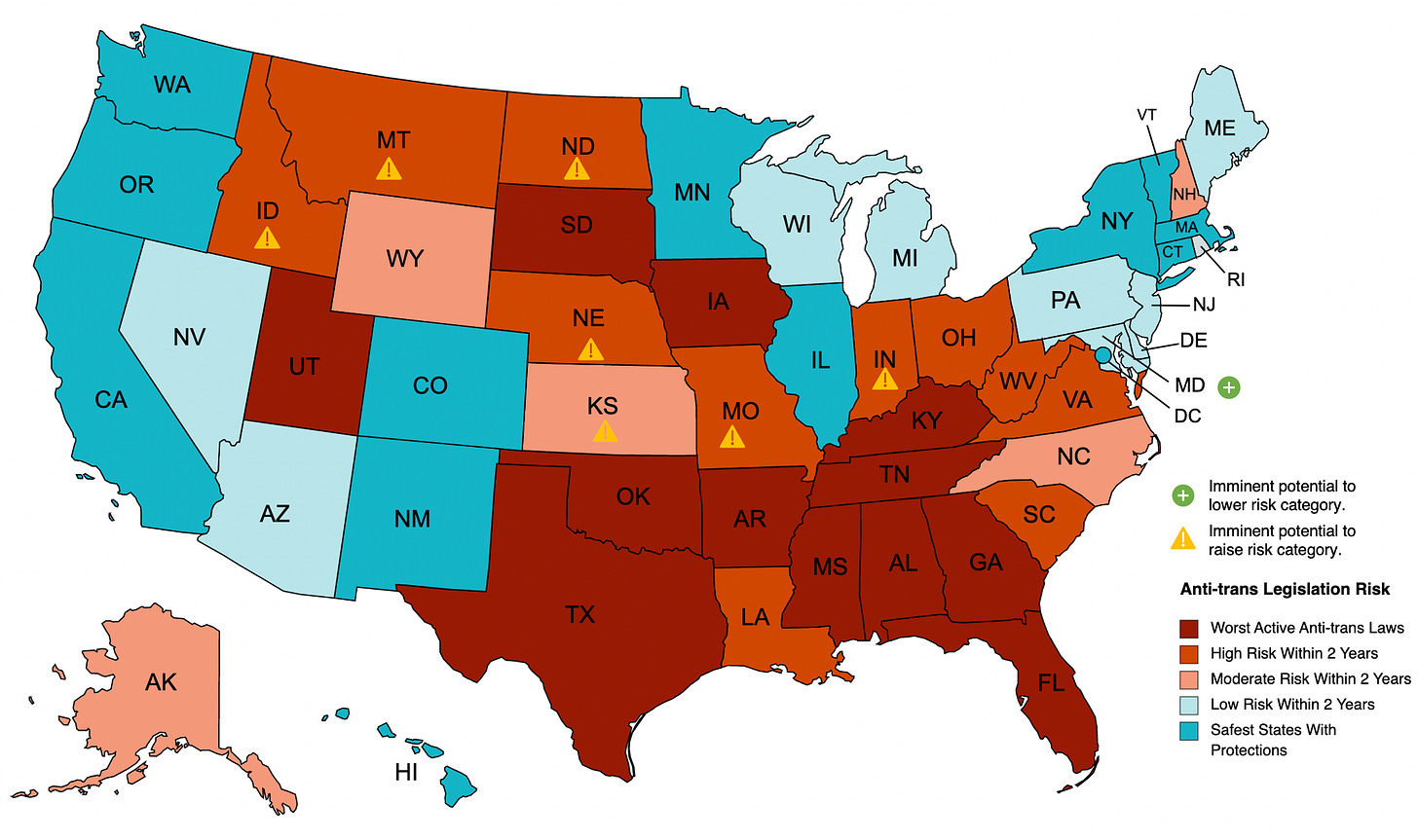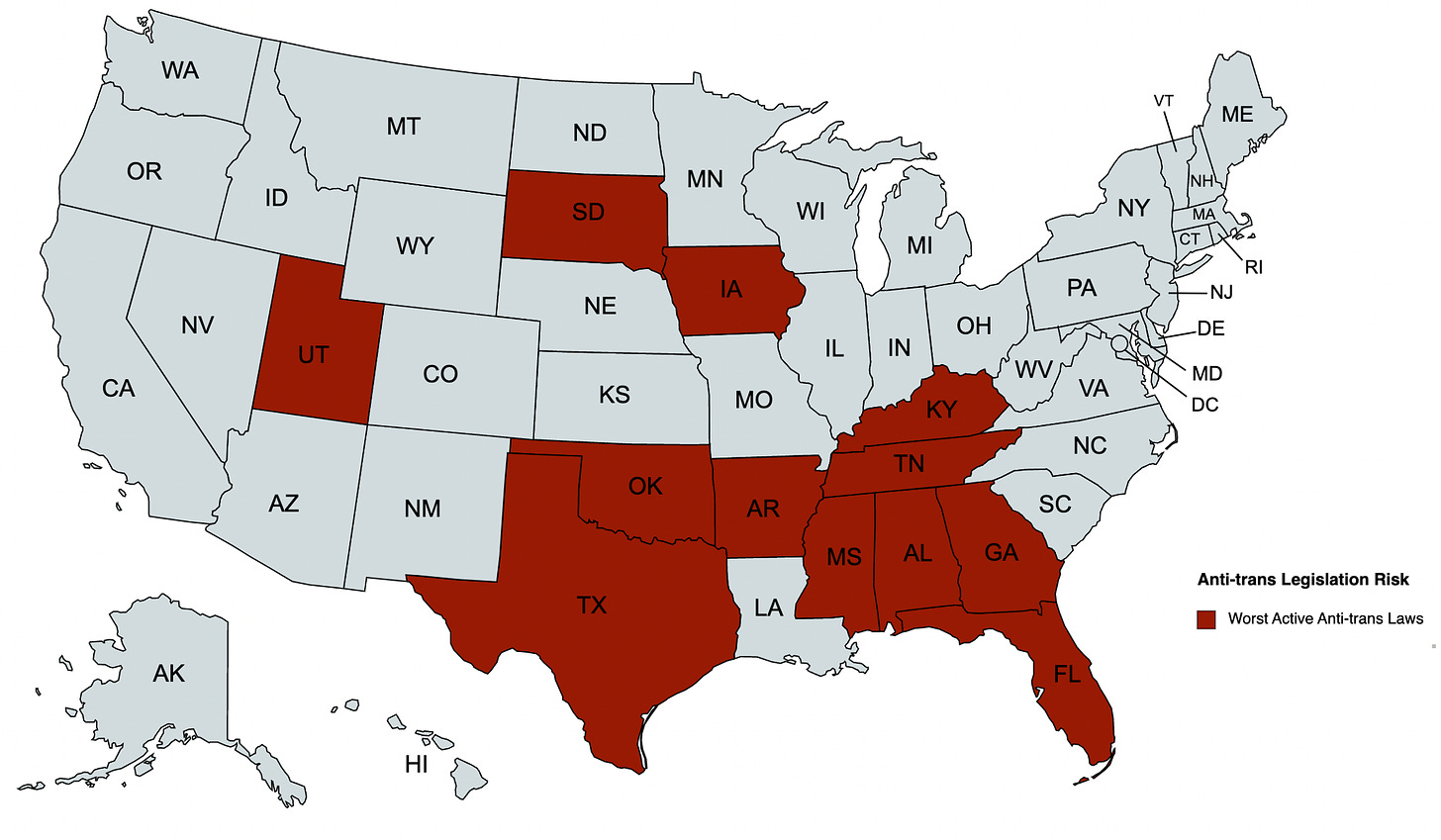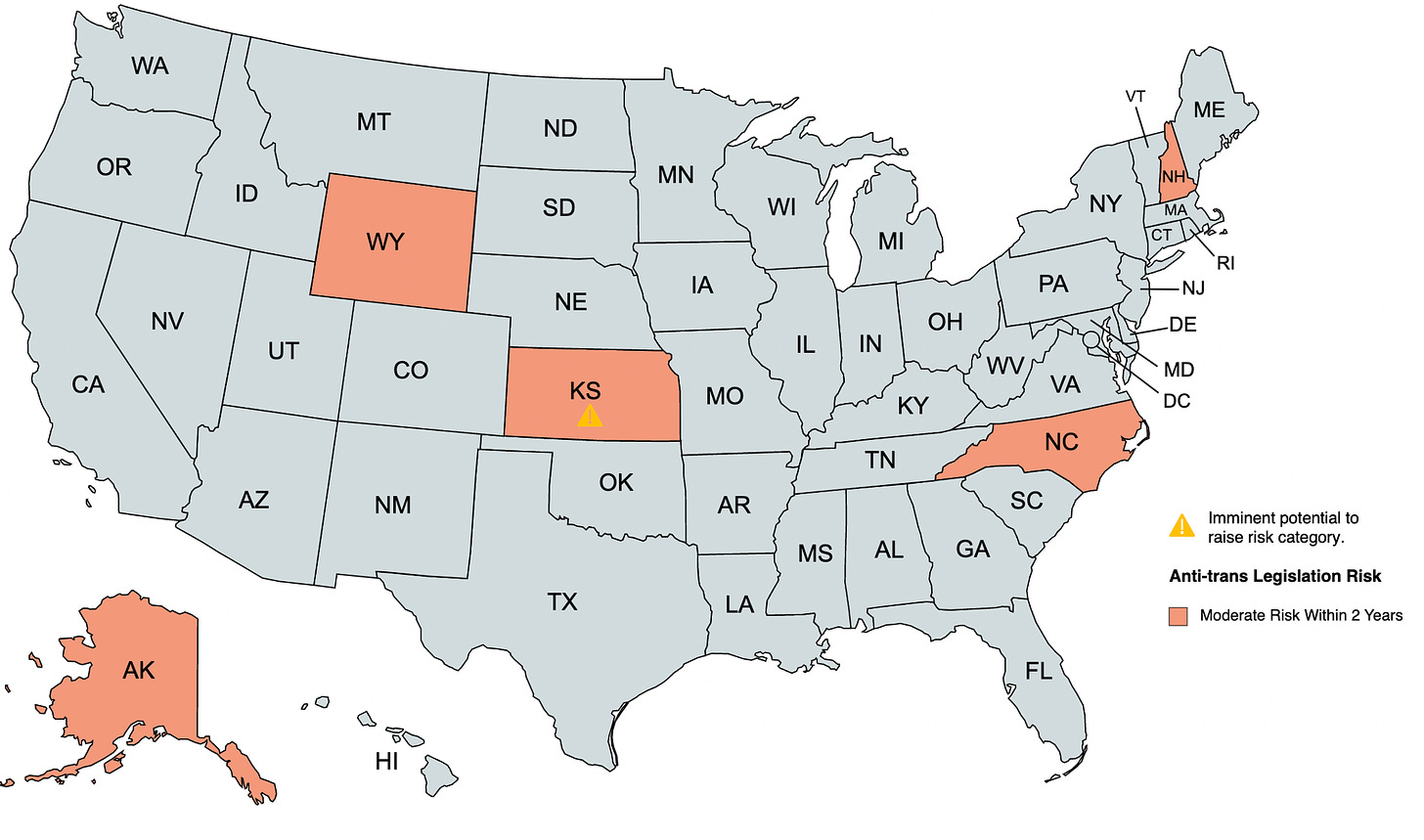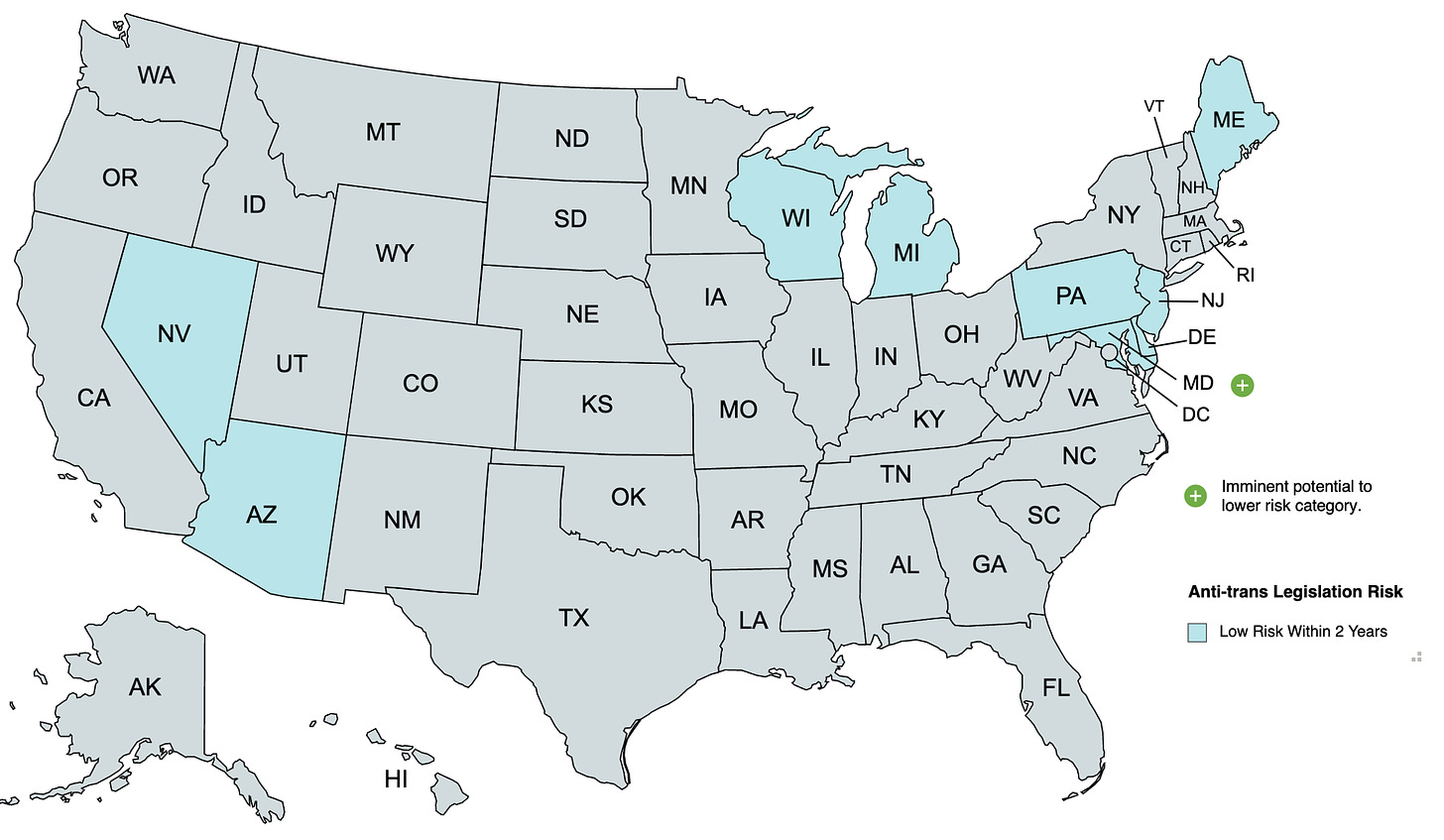March Anti-Trans Legislative Risk Map
We are now in the most busy portion of the legislative year. Bills that have passed one chamber are facing fierce resistance in the other. Some are passing, some are stalled. I assess the risk.
***THIS MAP IS OUT OF DATE. FIND THE MOST UP TO DATE ONE HERE.***
About The Map
I have tracked anti-transgender legislation for 3 years @erininthemorn on Twitter and TikTok. Every day, I’ve gotten messages from worried people wondering how they are supposed to assess their risk of staying in their home state. The messages range from parents of trans youth wondering if their children will be taken from them to trans teachers wondering if their jobs will be safe in coming years. Sometimes people just want to know if there is a safer state they can move to nearby.
I created the legislative risk map specifically to help answer that question. Now more than ever, it is a question that needs answering for so many transgender people facing forced medical detransition, bans on the use of our names, pronouns, and identification documents, and many other curtailments of our rights to exist in public life.
Methodology
The methodology I use is qualitative. I know the partisan breakdowns of the various states. I have watched hundreds of hours of hearings on anti-trans legislation and am fully aware of all of the players nationally as well as where they are making their pushes against trans rights. I have followed the vote count and talk to activists on the ground in each state. I also take into account election results - the last election shifted several states into lower risk due to Democratic victories at the state level. I am looking at how similar states are moving in their legislative cycles. Lastly, I watch for statements by governors and bill drafts to see if the Republican party in various states seems to be pushing anti-trans legislation heavily - you can see many examples of such legislation on this newsletter.
Changes Since Last Map
The last two weeks have brought forth many changes in state risk level. Several states passed extremely harmful new legislation such as gender affirming care bans for trans youth - these states include Georgia, Iowa, and Kentucky, which have all moved into ranks of the states with the worst active anti-trans laws. Other states have passed bills that protect the community in extremely important ways - New Mexico passed a bill that protects the right to gender affirming care, and Minnesota's governor signed one of the broadest executive actions I have ever seen protecting trans refugees fleeing other states that criminalize trans care.
Some states no longer feature warnings that they are about to move into a higher risk category. West Virginia’s session is adjourned sine die and therefore cannot pass any new bills this cycle. They still retain a high risk to account for upcoming 2024 elections, but at least for the rest of the year, they will likely not change risk levels. Maryland, on the other hand, still retains a green plus sign due to potential passage of the Trans Health Equality Act, which will allow trans people to obtain modern standards of care with Medicaid coverage.
There exists one state that is on the edge between low risk and safest states: Michigan. Michigan’s status has not changed since the last map, but it is important to note the passage of an equality law that protects gender identity and sexual orientation from discrimination. However, Michigan still lacks things like a refugee protection law from other anti-trans states, coverage for modern standards of care in health insurance, no-hassle removal of publication requirements for name changes, mandated LGBTQ+ teaching in schools, and a banning of the gay and trans panic defense. Thus, Michigan will remain at low risk, despite this major achievement. I hope to move them into the ranks of the “safest states” eventually.
The Worst States
Alabama
Arkansas
Florida
Georgia
Iowa
Kentucky
Mississippi
Oklahoma
South Dakota
Tennessee
Texas
Utah
These states have passed the worst anti-transgender legislation or enforced existing laws against transgender already. The worst laws appear in these states. Texas is home to the weaponization of DFPS against transgender people and 34 anti-trans bills proposed this cycle. Alabama, Arkansas, Florida, Georgia, Iowa, Kentucky, Mississippi, South Dakota, Tennessee, and Utah have all also passed gender affirming care bans for trans youth. Tennessee recently passed a bill banning drag in public that could even target pride. Oklahoma currently has the most anti-trans bills of any state proposed. Florida has banned medicaid coverage for trans adults and has some of the worst anti-trans bills proposed right now - including a bill that would fine people $35,000 for accusing someone of transphobia. Kentucky just passed SB150, which tells doctors how to detransition trans youth. These are the states I get the most questions from people asking where they can flee.
High Risk States
Idaho
Indiana
Louisiana
Missouri
Montana
Nebraska
North Dakota
Ohio
South Carolina
Virginia
West Virginia
This list is the one to watch for current and future legislation. All of these states are at high risk of moving into the ranks of the “worst states” in terms of anti-trans laws. Ohio, West Virginia, Virginia, South Carolina, and Louisiana are art high risk, but are not in imminent danger of passing one of the major anti-trans bills. That does not mean that trans people in them can rest easy - states can rush through bills like we saw in places like Iowa and Kentucky this last week, which both rushed through gender affirming care bans.
The Mountain West and Plains states feature a lot of extremely dangerous anti-trans legislation. Montana’s drag ban has advanced to the Senate, and the gender affirming care ban will be heard soon in the House. Idaho has a drag bounty ban moving as well as a care ban. Nebraska has been the site of a filibuster by Senator Cavanaugh, who has ended the filibuster presumably because she believes the medical ban bill there can be beaten.
Missouri and Indiana are both at imminent risk as well. Missouri also has an active filibuster going. This is in order to stop a wave bad bills that target drag, gender affirming care, and more. Indiana’s gender affirming care ban recently passed one legislative chamber and could go into law if it is not beaten back before the next risk map is published.
One important note is that Virginia is also at high risk even though its anti-trans bills were beaten this cycle. That is because Glen Youngkin is using the powers of the governorship to directly target transgender youth. His model anti-trans school policies will result in forced outing of trans students, bathroom bans, pronoun bans, and more should they be adopted.
Moderate Risk States
Alaska
Kansas
New Hampshire
North Carolina
Wyoming
This list of states has shrunk by one - Georgia moved directly out of this category and into the “worst states” category with the passage of its gender affirming care ban for trans youth. The rest of the states on this list represent special circumstances that make them hard to predict. North Carolina’s anti-trans medical care ban did not even get a committee hearing last year and it was the site of the famous bathroom ban, which has made them hesitant to pass further legislation. There are bills that are moving there and the veto override margin is very tight, should the Democratic governor veto them. New Hampshire has a Republican majority, but one that has been more liberal than other states and has stayed away from passing anti-trans laws. Alaska has been relatively quiet on this front as well, though there are some sports and education bans on the move there.
Kansas has a Democratic governor, but the veto margin is similarly small there. Kansas deserves a special mention though as well as an exclamation point because several anti-trans bills have passed at least one legislative chamber there. This makes the state particularly risky, especially if any of the bills get sent to the governor.
Low Risk States
Arizona
Delaware
Maine
Maryland
Michigan
Nevada
New Jersey
Pennsylvania
Rhode Island
Wisconsin
This list has shrunk by two for this release: Minnesota and New Mexico have moved to the safest states due to passage of protective laws.
These states have a low risk of enacting extreme anti-transgender legislation within a single election cycle. Still, these states are unified by a lack of the strongest transgender protections. States like New Jersey, Rhode Island, and Delaware all lack major healthcare protections for transgender people and are not currently considering refugee bills protecting trans people who are fleeing the aforementioned unsafe states.
Arizona and Wisconsin saw positive election results last cycle and they remain low risk. Arizona has seen a number of anti-trans bills pushed forward, but there has been no indication that the Democratic governor has any interest in signing them.
Maryland is in line to move to the “Most Protective States” category if it passes a bill that would give those on Medicaid coverage for FFS, hair removal and more.
Michigan remains in this category despite the passage of its equality act. It still lacks other major protections such as a refugee protection law from other anti-trans states, coverage for modern standards of care in health insurance, no-hassle removal of publication requirements for name changes, mandated LGBTQ+ teaching in schools, and a banning of the gay and trans panic defense.
Most Protective States
California
Colorado
Connecticut
Hawaii
Illinois
Massachusetts
Minnesota
New Mexico
New York
Oregon
Vermont
Washington
Washington, D.C.*
Transgender people in these states are better protected culturally and legally than in other states. States like Hawaii, Colorado, and Washington maintain explicit transgender healthcare policies that cover surgeries that often go without coverage in other states. Washington, D.C., Massachusetts, Connecticut, and California are currently considering policies or have passed policies that protect transgender refugees fleeing from other states.
Other states in this category like Illinois, Oregon, New York, Massachusetts, and Vermont maintain a strong history of transgender protections and show yearly legislation proposals to further protect transgender residents.
Two new states join these rankings for this release. Minnesota’s governor passed an extremely important executive order protecting fleeing trans refugees from unsafe states and protecting their healthcare. New Mexico passed a law that protects the right to gender affirming care.









Thank you so much for your work, it’s invaluable.
Thank you so much for putting this together!